

ANTIBIOTICS 21/05/21 Back to Basics: Choosing the Appropriate Surface Disinfectant. 4.1.1.
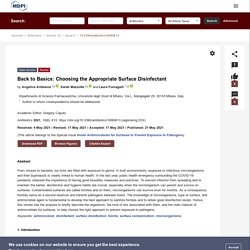
Chlorine Compounds Historically, the most widely used antimicrobial agents belonging to halogens are chlorine and chlorine releasing compounds. Since elemental chlorine gas (Cl2) is hazardous it must be banned either from workplaces or household environment and substituted by chlorine-releasing agents. The most commonly used chlorine-releasing agent is sodium hypochlorite (NaOCl), universally known as bleach, which is characterized by high microbicidal efficacy, low toxicity to humans, and low cost, but suffers the disadvantages of being irritant and corrosive. Nevertheless, ceramics, methylacrylate, or cement are not sensitive to bleach.
FOODS 30/11/20 Emerging Technologies for Aerial Decontamination of Food Storage Environments to Eliminate Microbial Cross-Contamination. PMMI: The Association for Packaging and Processing Technologies via YOUTUBE 23/10/19 Clean in Place CIP Across Food and Dairy Plants. FOOD SAFETY MAGAZINE - AVRIL 2019 - Reduced Moisture Design & Sanitation: Best Practices. Sanitation | April/May 2019 By Karl Thorson Water is fun.

It provides nutrients, quenches thirst, and cools us off on hot summer days. Water or moisture is also necessary to support certain types of sanitation. However, traditional wet cleaning methods involve large volumes of water and, often, liquid chemicals. FOOD SAFETY MAGAZINE - AOUT 2019 - The Importance of Cleaning for Food Safety. Sanitation | August/September 2019 By Barbara Kanegsberg and Ed Kanegsberg, Ph.D.
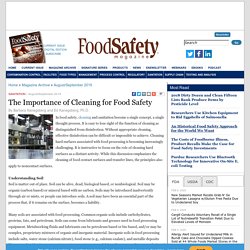
In food safety, cleaning and sanitation become a single concept, a single thought process. It is easy to lose sight of the function of cleaning as distinguished from disinfection. Without appropriate cleaning, effective disinfection can be difficult or impossible to achieve. Cleaning hard surfaces associated with food processing is becoming increasingly challenging.
Understanding Soil Soil is matter out of place. Many soils are associated with food processing. SEAFOOD HACCP ALLIANCE COURSE - 2000 - Sanitation Control Procedures for Processing Fish and Fishery Products. JOURNAL OF APPLIED MICROBIOLOGY 04/10/17 Incorporating germination‐induction into decontamination strategies for bacterial spores. Introduction In the mid‐19th century, Perty and Pasteur published the first observations of bacterial spores.
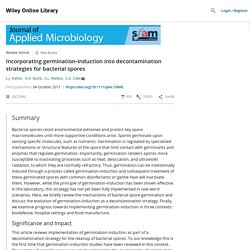
Cohn built upon this work by witnessing the germination of spores under the microscope (Morrison and Rettger 1930). The advent of molecular genetics in the mid‐20th century facilitated the identification of bacterial genes involved in germination. At the same time, germinants, germination enhancers, and germination inhibitors were also being identified. Members of the Clostridia and Bacillus genera are the most‐studied bacterial species that form spores. Anatomy of the spore The structure of the spore allows it to evade severe environmental conditions such as heat, cold, desiccation and ultraviolet (UV) radiation (Driks 2002, 2003). The bacterial genome, as well as tRNAs, ribosomes, and most enzymes within the spore, are contained within the spore core.
Moving outward from the spore core is the inner membrane. VKM_NO 18/04/16 Assessment of the requirements for information needed for health and environmental risk assessments of microbiological cleaning products. The current information requirements regarding cleaning products containing microorganisms is not sufficient to conduct health and environmental risk assessments of such products.

That is the main conclusion in a report conducted by the Norwegian Scientific Committee for Food Safety (VKM). The Norwegian Environment Agency has requested the report. Cleaning products with bacteria or other microorganisms as active ingredients are becoming more common. There are currently no uniform, international regulations governing the production and use of such products. The declaration form According to the Norwegian regulation on the declaration and labelling of microorganisms, importers, manufacturers as well as distributors of microbiological products in Norway are required to label and declare products in the Product registry employing a separate declaration form. Limited information today Scope of usage and precautions Furthermore, the declaration should contain information relating to user groups. UNIVERSITY OF GEORGIA - 1999 - Cleaning, sanitizing & pest control in food processing, storage and service aeras.
SCIENTIFIC RESEARCH - JULY 2013 - Bacteria on Meat Abattoir Process Surfaces after Sanitation: Characterisation of Survival Properties of Listeria monocytogenes and the Commensal Bacterial Flora. Contamination of food with spoilage bacteria and pathogens from food processing environment remains a challenge for the food industry.

Bacteria able to persist in such environments over time must survive several hygienic hurdles. The aim of this study was to identify bacteria surviving practical disinfection and compare their survival abilities with representative isolates of the pathogen Listeria monocytogenes. INTERNATIONAL BIODETERIORATION - 2003 - Bacterial disinfectant resistance—a challenge for the food industry. Int. J. Environ. Res. Public Health 2015, 12(8), 8658-8677 Effect of Disinfectants on Preventing the Cross-Contamination of Pathogens in Fresh Produce Washing Water. 1 RIKILT - Wageningen UR (University and Research Centre), P.O.
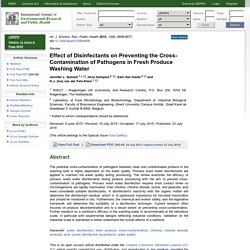
Box 230, 6700 AE Wageningen, The Netherlands 2 Laboratory of Food Microbiology and Biotechnology, Department of Industrial Biological Sciences, Faculty of Bioscience Engineering, Ghent University Campus Kortrijk, Graaf Karel de Goedelaan 5, Kortrijk B-8500, Belgium * Author to whom correspondence should be addressed. Received: 9 June 2015 / Revised: 15 July 2015 / Accepted: 17 July 2015 / Published: 23 July 2015 The potential cross-contamination of pathogens between clean and contaminated produce in the washing tank is highly dependent on the water quality. Process wash water disinfectants are applied to maintain the water quality during processing.
This is an open access article distributed under the Creative Commons Attribution License (CC BY) which permits unrestricted use, distribution, and reproduction in any medium, provided the original work is properly cited. Ciênc. Tecnol. Aliment. vol.32 no.2 Campinas Apr./June 2012 Epub Apr 17, 2012 Influence of different sanitizers on food contaminant bacteria: effect of exposure temperature, contact time, and product concentration.
Influence of different sanitizers on food contaminant bacteria: effect of exposure temperature, contact time, and product concentration Influência de diferentes sanitizantes na contaminação de alimentos por bactérias: efeito da temperatura de exposição, tempo de contato e concentração de produto Cezar Augusto BeltrameI; Gabriela Busnello KubiakI; Lindomar Alberto LerinII; Ieda RottavaII; Altemir José MossiI; Débora de OliveiraI; Rogério Luis CansianI; Helen TreichelI; Geciane ToniazzoI, *
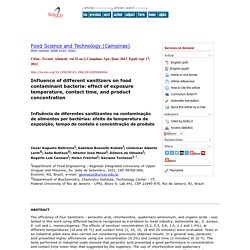
AGENCIA NACIONAL DE VIGILANCIA SANITARIA 04/11/13 GUIDANCE FOR CLEANING AND DISINFECTION PROCEDURES ON VESSELS CARRYING SUSPECTED CASES OF TRANSMISSIBLE DISEASES ON BOARD. DAFF_GOV_AU 13/12/13 Contamination treatment guide. Introduction One of the Department of Agriculture and Water Resources primary roles is to address biosecurity threats to Australia’s primary production sectors, the environment and human health, while also supporting tourism and trade.

To do this, the department provides import and export inspection and certification to help retain Australia's highly favourable animal, plant and human health status and wide access to overseas export markets. The department also manages biosecurity controls at our borders to minimise the risk of exotic pests and diseases entering the country. Imported cargo may be subject to targeted or random inspection by biosecurity officers who are trained to look for biosecurity risks on imported cargo. ECOLAB - 2013 - How important is cleaning for successful plant hygiene in food processing plants? HACCP AUSTRALIA - 2015 - HACCP FOOD SAFETY BULLETIN - Au sommaire: CONTRACT CLEANING IN PRODUCTION ZONES - Ecowize have what it takes to meet the world’s best practice. USDA - 2011 - Présentation : Cleaning and disinfection - roles and responsabilities basic protocol. KANSAS STATE UNIVERSITY - 2012 - Thèse en ligne : EVALUATION OF A SANITIZING SYSTEM USING ISOPROPYL ALCOHOL QUATERNARY AMMONIUM.
Int. J. Environ. Res. Public Health 2013, 10, 6169-6183 Methods for Recovering Microorganisms from Solid Surfaces Used in the Fo. Rheinischen Friedrich-Wilhelms-Universität 31/05/10 Dissertation en ligne : Assessment of sustainable antimicrobial methods with. Health and Population - Perspectives and Issues 24(4): 189-197, 2001 A STUDY OF CLEANING/DISINFECTING PROCEDURES IN A PREMIER TE.